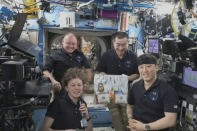Truth matters. Community matters. Your support makes both possible. LAist is one of the few places where news remains independent and free from political and corporate influence. Stand up for truth and for LAist. Make your tax-deductible donation now.
UC Berkeley scientists confirm Jupiter ‘mushballs’ form in lightning storms

Large balls of slush and ice rain down on Jupiter during the gaseous planet’s lightning storms, planetary scientists at UC Berkeley said this week.
The mushball theory — initially proposed in 2020 to explain the lack of mixing in Jupiter’s atmosphere — struck UC Berkeley graduate student Chris Moeckel and his advisor, Imke de Pater, professor emerita of astronomy and Earth and planetary science, as outlandish, bizarre and unlikely.
“I like Occam’s razor. I like simple explanations, even if they’re complex problems. My initial gut reaction was, there’s no way this can be possible,” Moeckel said.
These mushballs can be the size of a human head and the consistency of a gas station slushie. For them to form, a variety of parameters have to align in a precise way that would make Goldilocks seem easy to please.
“I thought it can’t be true, it’s just too exotic,” Moeckel said. “Then I spent the next four years trying to disprove the theory and didn’t quite manage.”
Indeed, further inquiry only cemented the likelihood that mushball hailstones of ammonia and water ice formed during intense lightning storms were the most likely explanation. His response to the discovery? “I was a bit annoyed.”

Moeckel received his Ph.D. as part of this investigation and is now a researcher at UC Berkeley’s Space Sciences Laboratory. He and colleagues described their findings in a recent issue of the journal Science Advances.
Here’s why the mushball theory seemed so preposterous. Prior to the launch of the Juno mission, a NASA space probe launched in 2011, now in orbit around Jupiter, scientists generally thought that other planets would be similar to Earth, where the incoming sunlight generally drives weather and climate.
“We went to Jupiter and thought, well, probably it’s gonna look very similar to Earth. And then one of the big things that the Juno mission had found was that our Earth-based approach could not explain what we’re finding,” Moeckel said.
Scientists discovered that some ingredients of the atmosphere were not acting as they expected.
Picture Jupiter, a storm-rich gas planet bubbling and swirling like tie-dye in motion.
“You’re seeing all of these different storms, all of these different colors. So you expect everything is well-mixed, right? It looks like a boiling pot,” Moeckel said.

However, Juno found that ammonia gas, which they thought should be everywhere in the atmosphere as it would be around Earth, was effectively missing from the outside of the planet hundreds of kilometers deep. They could not explain it — hence the development of the mushball theory.
Moeckel now believes this phenomenon is likely present on other gas planets, such as Saturn, Neptune and Uranus, as well. But this complicates our picture of those planets.
Scientists wielding the powerful James Webb Space Telescope discovered many new planets beyond the bounds of our solar system, most of which appear to be gas planets where mushballs may also rain down.
This shift toward complexity, not assuming other planets work like Earth, is most interesting to Moeckel.
“When we look at these planets, we normally think, OK, what’s the climate doing? And now we’re starting to understand that it is a little bit more complex than that. We cannot just make a back-of-the-envelope calculation about the climate [based on the nearest star]. We also have to take into account the weather dynamics and how those dynamics affect our observations.”
In an added bit of poetry, Moeckel pointed out that the Roman god Jupiter — Zeus in the Greek pantheon — is the divine wielder of lightning bolts. These mushballs also appear to play well with lightning.













